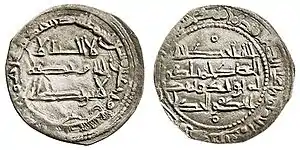| Muhammad I of Cordoba محمد بن عبد الرحمن الأوسط | |
|---|---|
 Silver dirham minted during the reign of Emir Muhammad I. | |
| 5th Emir of Córdoba | |
| Reign | 852–886 |
| Predecessor | Abd ar-Rahman II |
| Successor | al-Mundhir |
| Born | 823 Córdoba |
| Died | 886 (aged 62–63) Córdoba |
| Dynasty | Umayyad dynasty |
| Father | Abd ar-Rahman II |
| Mother | Nahtiz |
| Religion | Islam |
Muhammad I of Cordoba (823–886; Arabic: محمد بن عبد الرحمن الأوسط) was a Muslim ruler of al-Andalus.[1] He ruled during a time of thriving art, architecture and culture in Islamic Iberia in the 9th century, turning Cordoba into a cultural and political center.
Reign
According to the late 9th century Chronica Prophetica, the Umayyad dynasty began its rule over al-Andalus in 746 and brought much stability to the Iberian Peninsula compared to their predecessors. They had been in control of the caliphate since the death of the prophet Muhammad until the Abbasid dynasty took over in the 750s.[2] Cordoba became the capital and cultural center of al-Andalus.[1]
During this time period, the number of Muslims in al-Andalus increased. Although North African Muslims were immigrating to the Iberian Peninsula, there were even more Spanish Christians converting to Islam whether out of actual faith or as a means to advance in the new Islamic society.[2]
Although both Christians and Jews were tolerated, the only way to become fully integrated and accepted into Andalusian society was to give up one's faith and conform to Islam. There were many who did not convert but still learned how to speak Arabic and dressed in the Arab fashion.[2] However, Cordoban Christians were expected to pay an additional tax in return for being able to openly practice their faith.[3] Christians and Jews who abided with the new Islamic society were still able to practice their religion as long as they did not criticize Islam.
He engaged in diplomacy with Charles the Bald, the Carolingian king of the West Franks, sending him camels in 865.[4]
Martyrs of Cordoba
Under the reign of Muhammad I, what became later known as the Cordoban Martyr Movement took place. While a majority of Cordoban Christians conformed to Islamic society and lived comfortably as a result, there were still some who fervently defended their faith. During the mid 9th century there was a group of outspoken Cordoban Christians who publicly denounced the Muhammad.[3] As a result of their protests, 50 Christians were executed by the Umayyad government. The source of this event comes from a rediscovered 16th century manuscript.[2][5]
Architecture
.jpeg.webp)
Muhammad I is credited with some of the work done on the Great Mosque of Cordoba in the 9th century. He may have completed the first major expansion of the mosque begun by his father, Abd ar-Rahman II.[6][7] He also added a maqsura.[6] In 855 he restored the entrance called Bab al-Wuzara' ("Gate of the Viziers"), known today as the Puerta de San Esteban, which is an important early example of the prototypical Moorish gateway.[8][6][7]
One of Muhammad I's wives, Umm Salama, also founded a cemetery and a mosque named after her in the northern suburbs of Cordoba. Over time, this cemetery turned into the city's largest.[9][10]
References
- 1 2 Monterroso Checa, Antonio; Monferrer-Sala, Juan Pedro (2023-03-06). A Companion to Late Antique and Medieval Islamic Cordoba. BRILL. pp. 142, 149, 312. doi:10.1163/9789004524156. ISBN 978-90-04-52415-6.
- 1 2 3 4 Lowney, Christopher (2012). A Vanished World: Medieval Spain's Golden Age of Enlightenment. Simon and Schuster. pp. 57, 63–64. ISBN 978-0-7432-8261-1.
- 1 2 Wolf, Kenneth Baxter (2000), "Muḥammad as Antichrist in Ninth-Century Córdoba", Christians, Muslims, and Jews in Medieval and Early Modern Spain, University of Notre Dame Press, p. 5, doi:10.2307/j.ctvpj7bxm.5, retrieved 2023-11-16
- ↑ Ottewill-Soulsby, S. G. (2019-07-03). "The Camels of Charles the Bald". ISSN 1380-7854.
{{cite journal}}: Cite journal requires|journal=(help) - ↑ Ihnat, Kati (2019). "The Martyrs of Córdoba: Debates around a curious case of medieval martyrdom". History Compass. 18. doi:10.1111/hic3.12603. hdl:2066/214737.
- 1 2 3 Dodds, Jerrilynn D. (1992). "The Great Mosque of Córdoba". In Dodds, Jerrilynn D. (ed.). Al-Andalus: The Art of Islamic Spain. New York: The Metropolitan Museum of Art. pp. 15–16. ISBN 0870996371.
- 1 2 Bloom, Jonathan M. (2020). Architecture of the Islamic West: North Africa and the Iberian Peninsula, 700-1800. Yale University Press. p. 21. ISBN 9780300218701.
- ↑ Barrucand, Marianne; Bednorz, Achim (1992). Moorish architecture in Andalusia. Taschen. p. 43. ISBN 3822896322.
- ↑ Safran, Janina M. (2013). Defining Boundaries in al-Andalus: Muslims, Christians, and Jews in Islamic Iberia. Cornell University Press. p. 84. ISBN 978-0-8014-6800-1.
- ↑ Murillo Redondo, Juan Francisco; Casal-García, María Teresa (2023). "The Suburbs of the Greatest City in the West". In Monferrer-Sala, Juan Pedro; Monterroso-Checa, Antonio (eds.). A Companion to Late Antique and Medieval Islamic Cordoba: Capital of Roman Baetica and Caliphate of al-Andalus. Brill. pp. 234, 245. ISBN 978-90-04-52415-6.
Sources
- Altamira, Rafael (1999). "Il califfato occidentale". Storia del mondo medievale. Vol. II. pp. 477–515.
- Calmet, Augustin, 1672–1757. (1767). Histoire Universelle, Sacrée et Profane. Chez Jean Renauld Doulssecker. OCLC 314190685.
{{cite book}}: CS1 maint: multiple names: authors list (link) CS1 maint: numeric names: authors list (link) - Ottewill-Soulsby, S. (2019). The Camels of Charles the Bald. doi:10.17863/CAM.8059.
